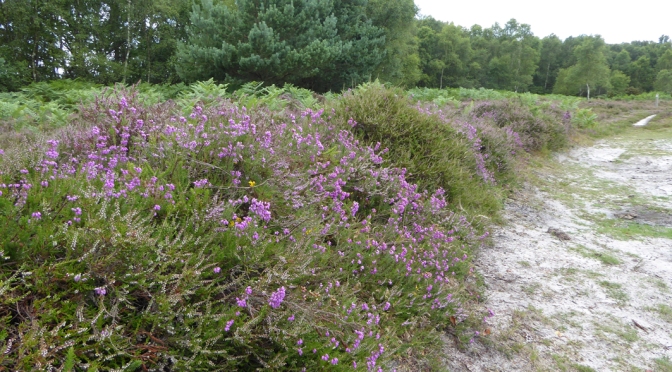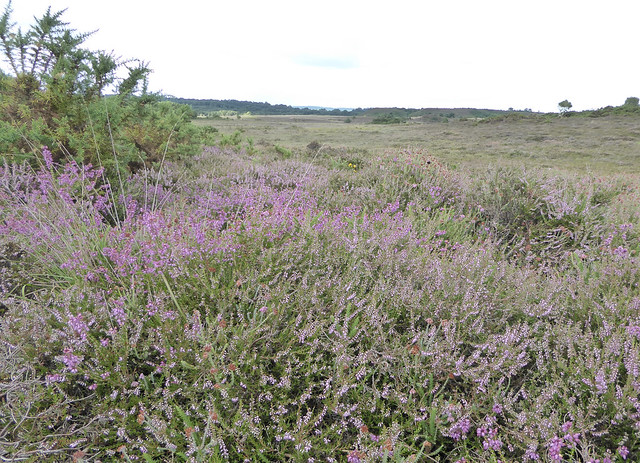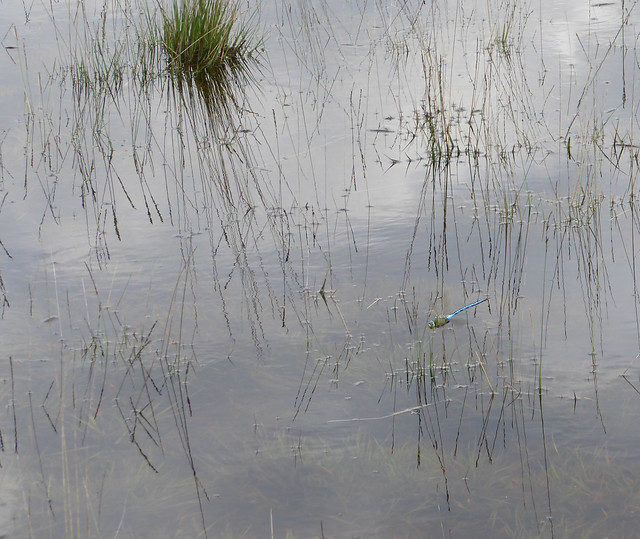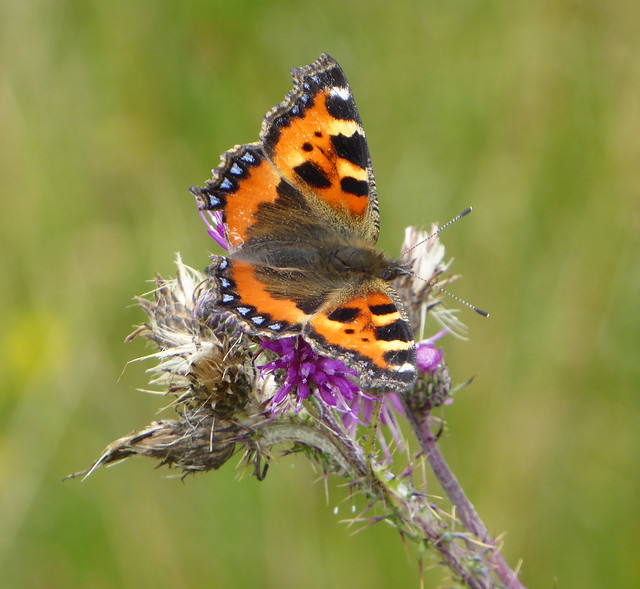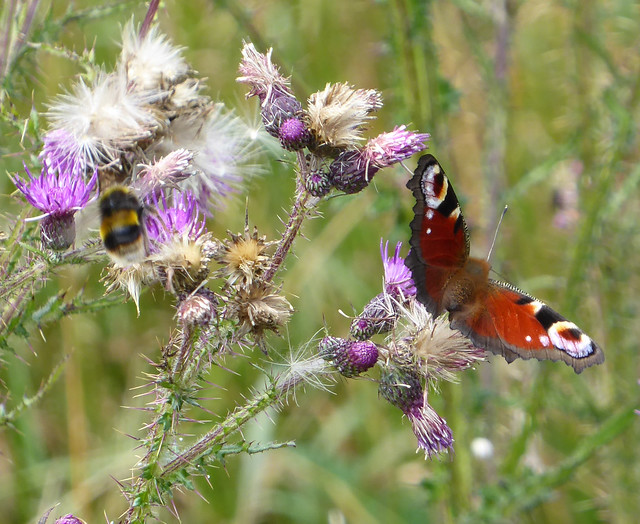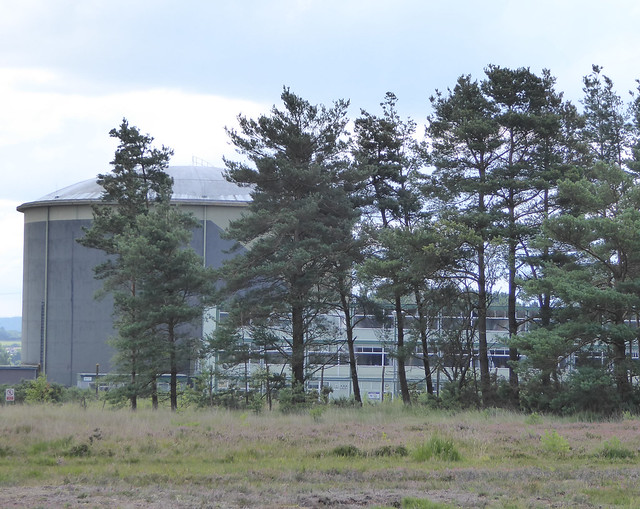The Pebblebed Heaths in East Devon constitute the largest block of lowland heath in the county. Named for the underlying pebble-rich geology, this extensive area of heathland lies along a ridge between the Otter and Exe rivers. Many rare creatures flourish here and numerous remnants of past lives are also dotted about. These include prehistoric burial mounds and earthworks but the archaeological jewel in the crown of this special East Devon place is the Iron Age hillfort of Woodbury Castle. Its extensive ramparts are at least 2500 years old but remarkably well preserved and holding a history well worth uncovering, as I found when I visited on a sunny day towards the end of August.
Woodbury Castle is situated on Woodbury Common, one of the tracts of heathland making up the Pebblebed Heaths and I parked in the visitors car park, set in a clearing surrounded by trees and scrub. Rose bay willowherb also grew there, its bright pink flowers partly replaced by white cotton wool seeds, a rather unsubtle reminder of the impending approach of autumn. The earthworks of Woodbury Castle were a short walk from the car park, partly concealed in a grove of broad leaf trees.
It was only when I got closer to the Castle that the size and extent of the earthen ramparts became clear. The main fortification consists of two impressive soil ridges, separated by a deep ditch, that snake their way around the perimeter of the site (see plan below). Further soil barriers and ditches provide additional protection in some parts. In the past, visitors were able to scramble across the earthworks leading to considerable erosion. Recent repairs have added wooden stairways to protect the ramparts and provide easier access.
I climbed the stairway over the lower ridge and paused at the bottom of the ditch to get a better view of the ramparts and to appreciate their size. After scaling the second, higher ridge, I descended about 3 metres into a large, roughly oval, open area approximately the size of two football pitches. This is the main enclosure protected by the fortifications. Dappled light filtered through the mature beech trees growing there creating a peaceful scene.
Helpful information boards with pictorial reconstructions were provided, giving some idea about contemporary life. Large earthworks such as these were probably centres for tribal groups. They would have required a huge effort to build and perhaps reflected the status of the community, being as much about display as defence. Excavations have provided evidence that the enclosure contained several thatched roundhouses where people lived and a granary raised above the ground to protect the contents. The site is interrupted by the road splitting it into two sections, making it difficult to envisage the full extent of the enclosure. This apparent desecration of an ancient site is not, however, recent and a track is thought to have existed here for many hundreds of years.

I paused to stand in the enclosed area and tried to imagine life at the time. I smelt woodsmoke from fires in the roundhouses and heard the chatter of people and the noises they created as they went about their work including fashioning wooden items and spinning wool. A few were standing on the ramparts, perhaps watching for new arrivals or even invaders. Woodbury Castle is set on the highest point on the Heaths, 185 metres above sea level, and there would have been little tree cover at that time. Our lookouts would have enjoyed panoramic views across Woodbury Common – to the East over the Otter Valley, towards the sea at what are now Exmouth and Budleigh Salterton and to the west over the Exe Valley with views as far as Dartmoor and Exmoor on a clear day.
We know very little about what has happened at Woodbury Castle since prehistoric times but there are a few clues. In 1549 during the bloody Prayerbook Rebellion, armed forces may have camped in the earthworks before the inconclusive Battle of Woodbury Common. During the Napoleonic Wars, the Castle was used as an army training camp and since then Woodbury Common has been exploited periodically for military preparation. A large Royal Marines camp was built on the Common in the run up to the D-Day landings during WW2 and remains of the buildings can still be found among the heather. To this day, parts of the Common are used regularly for training by Royal Marines from Lympstone Barracks.
Most of the time, though, Woodbury Common is quiet and a popular place for walking. In the main, the landscape is undulating dry heathland with a low covering of gorse, bracken, heathers and a few trees but there are some small areas of wetland where the vegetation is richer. The Common is criss-crossed by clear paths and walking is exhilarating with occasional views across Lyme Bay to the south. Some paths are quite pebbly reflecting the underlying geology. Many rare species including the Dartford warbler, the nightjar and the heath potter wasp can be seen on the Common and the area is a Site of Special Scientific Interest. In 2020, the East Devon Pebblebed Heaths were designated as a National Nature Reserve in recognition of their unique habitat and wildlife.
When I visited, the heathers were in flower lending the heath a subtle purple tinge. Bell heather was beginning to turn but the ling (heather) was in full purplish-pink flower. Cross leaved heath with its pink bells also showed well in places. Whenever I stopped to look at the heather flowers, there was a background low buzz from the many honeybees foraging; local beekeepers were clearly doing well. On one occasion, though, I had left the main path and walked a little way on to the heath to examine the heathers when a voice boomed out behind me: “There are quite a few adders about! Just warning you!” I hadn’t seen any adders but I thanked the owner of the voice and retreated quickly back on to the path to continue my walk. A good number of butterflies were on the wing in the sunshine including small tortoiseshell and gatekeeper but the highlight was several brimstone butterflies dancing about above the heath like fragments of bright greenish sunshine.
This article also appeared in the October 2021 edition of the Marshwood Vale Magazine.








